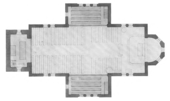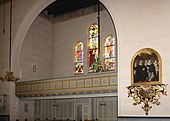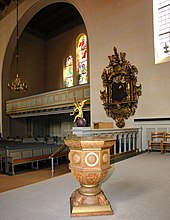St. Nikolai Church (Holbæk)
The Evangelical Lutheran St. Nikolai Church ( Danish Skt. Nikolai kirke ) in Holbæk is the parish church of St. Nikolai Sogn in Holbæk Municipality on the Danish island of Zealand . The brick church in neo-Romanesque style was built in 1868 in place of a medieval former monastery church, which was demolished due to dilapidation. Valuable inventory from the old abbey church was partially taken over.
history
Holbæk had three churches in the Middle Ages: St. Nikolai Church near today's ship bridge at the end of Ahlgade, which was named after Nikolaus von Myra , in the east the Vor Frue ( Our Lady ) Church in the village of Labæk and the one after Pope Lucius I. named and consecrated in 1323 monastery church Sct. Lucius . After the Reformation , first the Vor Frue church was demolished, then St. Nikolai in 1573 . The monastery, founded in 1275 by the Dominicans - the Black Brothers ( Sortebrødreklostret in Danish ) - was abandoned by the monks after the Reformation in 1536 and left it to the city. The monastery church was converted into a parish church, demolished in 1869 due to dilapidation and replaced by a new building. Only two wings remain of the monastery - Holbæk's only medieval building. Some of the valuable historical inventory has been sold, other items are now in the new church or in the Holbæk Museum and the National Museum .
architecture
In 1868 the new church was built according to plans by Professor Chr. Hansen (1803-1883). Hansen changed the development plan in 1869 by not orienting the building towards west-east - like the old abbey church - but in north-south direction. The red brick church with a granite base, built in the neo-Romanesque style, was consecrated in 1872. It has the shape of a cross with a square choir end in the south. The tower on the north side has a rectangular base, a square attachment at the height of the tower clock and above it an octagonal tower extension with a copper-covered spire. The church is 31.2 m long, 11.1 m wide and has a tower height of 45.2 m.
The architect also planned the interior of the church. Epitaphs and memorial plaques from the monastery church were only hung up decades later. In the first decade after its construction, the church was given the name Saint Nikolai .
Renovations
During the major renovation in 1930, the side galleries were lowered to get more light through the windows in the aisles. The windows in the apse were walled up so that the altar can be seen more to its advantage. Ole Søndergaard painted a fresco on the vault above the altar with deer drinking from the fountain of life at the foot of the cross. An organ gallery was built above the entrance and the walls and ceiling were painted a different color.
During the renovation in 1967 the stairs to the choir were widened and the two trumpet-blowing gold-plated angels by Lorentz Jørgensen came back into the church. The side windows in the side aisles were bricked up to strengthen the luminosity of the stained glass in the large windows. The organ gallery was lowered even further and a new organ with a new facade was installed. The interior and the seating got a new color scheme.
Stained glass window
The leaded glass windows in both aisles were made according to drawings by Professor Kræsten Iversen . An anonymous donation was made in 1945 for the west window motif, Return of Christ with cherubs on the sides, who wake the dead in their graves with trumpets. The windows in the east with the motifs Judas Kiss , Crucifixion and Resurrection are from 1949, they were financed by a collection in the church.
Furnishing
The pulpit and the baptismal font , like all the original furnishings - including the gallery facade and the 70 benches - were designed by the architect Christian Hansen in 1872. In 1930, new panels with evangelist symbols were made by the sculptor Hviid. The brass bowl of the baptismal font is a southern German work from around 1550, the stamps and engravings of which are no longer legible.
The votive ship - a model of Norske Løwe - was donated to the abbey church in 1750 by a merchant.
altar
The altarpiece Jesus and the Child (385 × 160-80 cm) was commissioned from Carl Bloch (1834–1890), a well-known painter of his time. The text under the picture according to ( Lk 18.17 EU ) reads in Danish “Sandelig siger jeg Eder: Hvo som ikke modtager Guds Rige som et Barn, kommer ingenlunde derind. Lucas Evang: 18 Cap: 17 verse. “ (Truly I say to you: Whoever does not accept the kingdom of God like a child will not enter it). The picture is signed "Carl Bloch 1873", it was not ready for the consecration of the church in 1872. On May 26, 1873, Carl Bloch wrote, “The picture is now finished and will remain in Charlottenborg until it is dry enough to be delivered to Holbaek”. A color lithograph is in the Holbæk Museum .
The altar screen and the altar retable are made of polished oak with gilding on the bases , capitals and moldings from 1872 . The altar originally had two side doors that separated the room behind with the confessional . The current altar table is from 1950.
Two of the four large altar candlesticks are from 1699, the others are copies from 1949. The seven-armed candlestick was donated in 1912.
chandelier
Six of the large brass chandeliers in the nave come from the abbey church, others are in the same style, but from 1930 and later. One chandelier in the choir was donated in 1713 by Mayor Donald Grubbe and his wife Sidsel Pop, the second is an imitation from 1930. In the west aisle hangs the oldest chandelier, donated in 1661 by councilors Kresten Thomsen and Sophia Albrechtdatter. Hans Olsen Sandøes and Jensdatters gave the chandelier in the east transept to four children in 1777, the family who also donated the votive ship. At the north end two candlesticks, donated by Anders Grubbe and Frau in 1725, and by Anders Christensen Brinch and Lena Nelsdatter in 1726. The small candlesticks above and below the organ gallery are from the 1950s and 1996.
organ
The main organ with 41 stops , 3 manuals, 1 pedal and back positive was built in 1967 by Th. Frobenius & Sønner ; it is the third organ in this church since 1872. The choir organ from 1990 comes from the organ builder Carsten Lund . It has a common registration with 4 bass and 6 treble registers and 1 manual.
Bells and chimes
Two old bells from the monastery church hang at the top of the tower, just below the top. The small "tolvklokken" (⌀ 90 cm) is attributed to the bell founder Hans Nielsen (Johannes Nicolai). It was cast around 1450 and has a Latin inscription: “Alpha et o (mega) b (e) u [instead of n ] (e) dic (tus) d (ominu) s ho (m) o rex gl (ori) e veni cu (m) pace amen ”.
The large bell (⌀ 111 cm) was cast in 1611 by Borchart Gelgiesser (Quellichmeyer). It bears the (mixed Latin, Danish, German) inscription: "Spes mea Christvs est Chriesten Rasmvsson Henni Bravnschweigk Kierckewerge to Holbecke Kercke verbvm Domini Manet in æternvm gos Michigan Borchart Gelgieser anno Domini 1611" (Christ is my hope. Christen Rasmussen., Henni Braunschweig , Parish council of Holbæk Church. The word of the Lord lasts forever. Borchart Gelgiesser (Quellichmeyer) poured me in the year of the Lord 1611).
In 1979 the donated carillon was inaugurated. The tower had to be reinforced for the 37 bells with a weight of 2,735 kg. The largest bell has two inscriptions in Danish: "Som den største af 37 klokker / alle skænket af Kristine Pedersen / til Skt. Nikolai kirke / støbtes jeg 1978 af Eijsbouts i Holland" and "Gud give mig til glæde at klinge" (God give me the joy of sounding).
The carillon with 25 bells, built by the Eijsbouts bell foundry in the Netherlands, runs automatically several times a day and has been computer-controlled since 1996. On special occasions, it can be played manually.
Tower clock
The tower clock - signed and dated: "Peter Mathiesen Copenhagen Anno 1737" - was taken over from the former abbey church. It controls the chiming of the clock for the quarter chimes on the small "tolvklokken" and the chiming of the hour on the big bell.
Epitaphs in the choir
On the west wall there is a memorial picture for a young girl, Karen Sørensdatter. The painting on wood shows the deceased kneeling next to the cross, on the frame male and female herms with arms in the form of twisted spirals. In the head piece the Christ monogram IHS , including a funerary inscription for Karen Søffren's daughter, who lived and died in Holbæk. In the pedestal a quote from ( Rom 5,8 EU ). A Renaissance work around 1625–1650, the original parts are made of oak, additions were made after 1896 (156 × 115 cm).
The picture on the east wall shows an unknown Holbæk citizen with two women and 11 children. It was referred to as a large 14-person epitaph in 1847, but with no names or dates. At the top, Christ sitting on the globe with four angels below. The painting on a metal plate (around 1650) was placed in a profile frame, the epithral frame has not been preserved (172 × 140 cm).
Epitaphs in the ship
The richly decorated epitaph in the baroque style on the east wall above the choir organ is attributed to the workshop of the sculptor Lorentz Jørgensen, who is known in the Holbæk region and was a pupil of Hans Gudewerdt the Younger from the Eckernförde carving school . The work (around 1649) shows in the painting on a metal plate City Councilor Peter Jensen (1583–1649) and his wife Margrethe Nielsdatter kneeling in prayer (125 × 94 cm).
On the west wall, between the organ and the gallery, an epitaph from 1648: Mayor Mogens Christensen (1569–1645), his two wives (Mette Lydersdatter, † 1624; Dorthe Lauridsdatter) and six children (four of whom died). Painting on lead plate (173 × 139 cm). Only the lower piece of the frame from Lorentz Jørgensen's workshop has survived; it is considered the best work of art in the church.
On the east wall between the gallery and the organ hangs the oldest epitaph with the inscription 1594. It has pictures on both sides as it was originally placed between two pillars of the abbey church. The painting shows in the visible part of Jakob Willumsen 19 children under the cross of Christ, only three were still alive when their father died. The initials at the foot of the columns stand for the widow (JHD = Johanne Hans Datters) and son Baltzer (BJ = Baltzer Jakobsens), who paid for the epitaph. On the other side, Jacob Willumsen († 1592), who was mayor of Holbæk for 30 years, kneels with one of his two wives at the foot of the cross. (Dimensions: 266 × 236 cm, image 113 × 113 cm)
Memorial plaques
The marble plaque under the organ on the eastern wall says that in 1643 the widow of City Councilor Søren Nielsen, Else Rasmusdatter, bought 200 rdl. ( Taler ) donated to have an altarpiece painted for the abbey church. Under the organ on the west side a stone from the burial chapel of the abbey church of Lehnsmann Mogens Packs (1577–1642) and his wife Berete Mund.
There are three limestone panels in the tower room:
- Mayor Anders Grubbe († 1726) and his wife donate three chandeliers to the church. The small chandelier in the tower room bears their names.
- In memory of the dealer Anders Andersen Borch († 1837) with a list of his foundations. The stone was commissioned by the estate administrator.
- Memorial plaque to carpenter JC Fugl († 1884) and his siblings for a large legacy in Holbæk.
literature
- Lis Grove-Rasmussen: Skt. Nikolai Kirke . HOLBÆK SKT. NIKOLAI MENIGHEDSRÅD, Holbæk 1997.
- Skt. Nikolaj Kirke og † Klosterkirke (PDF; 23.1 MB) In: IV, bind 4 (1990), Side: 2819 - 2940 . National Museum - Danmarks Kirker. Retrieved December 28, 2012.
Individual evidence
- ↑ Orgelbygger - Holbæk [Sjælland] Kirke . National Museum. Retrieved January 6, 2013.
- ↑ Orgelbygger - Holbæk [Sjælland] Kirke - Kororgel . National Museum. Retrieved January 6, 2013.
Web links
- Website Skt. Nikolai Kirke (Danish)
- Skt. Nikolaj Kirke og tidl. Monastery church in Danmarks Kirker (National Museum)
- Sankt Nikolai Kirke at nordenskirker.dk
- Sankt Nikolai Kirke at KortTilKirken.dk
Coordinates: 55 ° 42 ′ 58.7 " N , 11 ° 42 ′ 48.9" E












